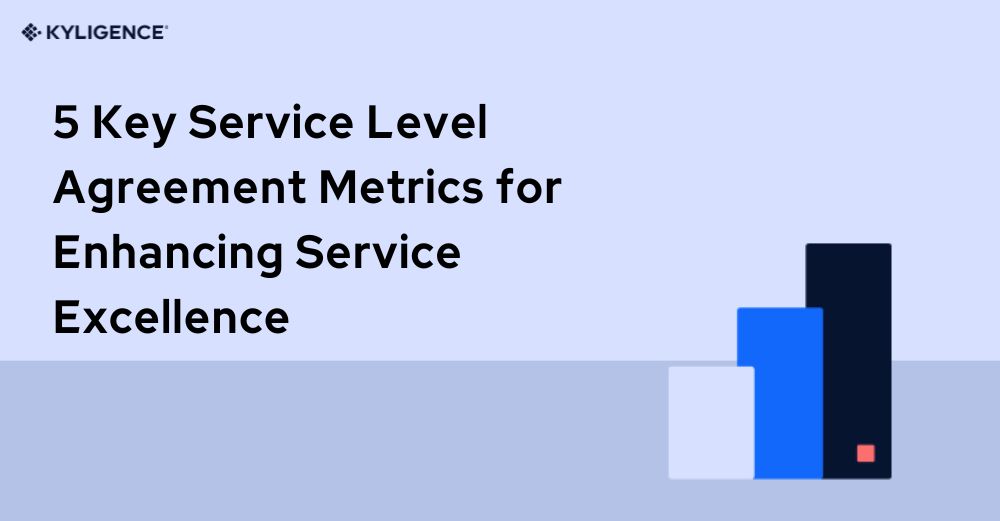Ⓒ 2023 Kyligence, Inc. All rights reserved.

Introduction
In today's competitive business landscape, delivering excellent service is crucial for organizations to thrive. But how can businesses ensure they are consistently providing high-quality service?
The answer lies in measuring and monitoring service performance through Service Level Agreement (SLA) metrics. These metrics act as a standardized framework for evaluating service excellence and identifying areas for improvement.
By understanding the importance of measuring service performance and utilizing the right SLA metrics, businesses can optimize their service levels and exceed customer expectations. So, let's explore the five key Service Level Agreement metrics that can enhance service excellence.
Importance of Service Level Agreement Metrics
Measuring service performance is essential for businesses to evaluate their service delivery and identify areas for improvement.
Without proper measurement, organizations may struggle to understand how well they are meeting customer expectations and where they need to make adjustments. This is where Service Level Agreement (SLA) metrics come into play.
SLA metrics provide a standardized framework for measuring and monitoring service performance. They establish clear benchmarks and targets that businesses can use to assess their service levels. By tracking these metrics, organizations can gain valuable insights into their performance and take proactive steps to enhance their service excellence.
Utilizing SLA metrics helps organizations set clear performance targets and measure their progress towards achieving them. It enables service providers to identify bottlenecks in their processes, address customer pain points, and improve overall service quality.
With the help of these metrics, businesses can optimize their operations, streamline workflows, and deliver exceptional service consistently.
Understanding the Need for Measuring Service Performance
Measuring service performance is essential for organizations to set clear performance standards and expectations for their service providers. By establishing measurable metrics, businesses can ensure that their service providers are meeting the desired service levels.
Without proper measurement, it becomes challenging to define what constitutes excellent service and hold service providers accountable.
In addition to setting performance standards, measuring service performance also helps identify areas for improvement. By analyzing the metrics, organizations can uncover trends, patterns, and potential issues that need to be addressed.
This enables businesses to take proactive measures in enhancing their service delivery and staying ahead of customer expectations.
For service companies, measuring performance allows them to evaluate their operations and identify opportunities for optimization. It provides insights into areas where they may be falling short or excelling- enabling them to make informed decisions on resource allocation and process improvements.
Similarly, for service vendors or suppliers, measuring performance helps them understand how well they are meeting contractual obligations and delivering value to their clients. It allows them to identify areas where they can enhance their offerings and differentiate themselves from competitors.
Exploring the Five Key SLA Metrics
Service Level Agreement (SLA) metrics play a crucial role in measuring and enhancing service excellence. Let's delve into the five key SLA metrics that can help businesses optimize their service levels and exceed customer expectations.
Response Time
Response time is a crucial Service Level Agreement (SLA) metric as it directly reflects the efficiency of customer service. It measures the duration taken to respond to customer queries or issues, and provides a clear indication of how promptly and effectively the business addresses customer needs.
A shorter response time not only signifies a high level of customer service but also contributes to enhanced overall customer satisfaction.
By prioritizing quick responses, businesses demonstrate their dedication to promptly resolving customer concerns and ensuring a positive customer experience. This emphasis on timely responsiveness can foster trust and loyalty among customers, as they feel valued and supported by the business.
Resolution Time
Resolution time is a vital metric that gauges the duration required to address and resolve customer issues or problems. It plays a crucial role in shaping the overall customer experience and serves as a reflection of efficient service delivery.
By focusing on reducing resolution time, businesses can significantly enhance customer satisfaction levels. When customers receive timely resolutions to their concerns, they feel valued and appreciated by the business.
This not only fosters positive sentiments but also builds a strong foundation of trust and loyalty. Efficiently resolving customer issues demonstrates the business's commitment to providing top-notch support and ensures that customers can quickly resume their normal operations or activities.
First Contact Resolution Rate
First contact resolution rate measures the percentage of customer issues resolved during the first interaction. A higher first contact resolution rate indicates effective problem-solving skills and reduces customer frustration. By resolving issues on the initial contact, businesses can save customers' time and effort, leading to increased satisfaction.
Customer Satisfaction
Customer satisfaction is a crucial SLA metric that measures the level of satisfaction customers have with the service provided. Regularly measuring customer satisfaction helps businesses identify areas for improvement and enhance overall service quality.
By understanding what drives customer happiness and contentment, organizations can make targeted improvements to deliver exceptional experiences.
Service Availability
Service availability measures the percentage of time a service is available to customers. High service availability ensures uninterrupted access to services, which enhances customer trust and loyalty.
By monitoring service availability closely, organizations can proactively address any downtime or disruptions, minimizing negative impacts on customers' experience.
By measuring these five key SLA metrics, businesses can get valuable insights for enhancing service excellence and meeting or exceeding customer expectations.
Conclusion
Measuring service performance through SLA metrics is crucial for enhancing service excellence and meeting customer expectations. By utilizing the five key SLA metrics discussed in this blog, organizations can optimize their service levels and exceed customer expectations.
These metrics provide valuable insights into various aspects of service delivery, and enable businesses to identify areas for improvement and make data-driven decisions.
To further enhance the measurement and analysis of service performance metrics, consider using Kyligence. With Kyligence's advanced features and capabilities, businesses can measure metrics more efficiently and gain deep data insights that drive continuous improvement.
Start leveraging Kyligence free today to unlock the full potential of your service excellence initiatives.
